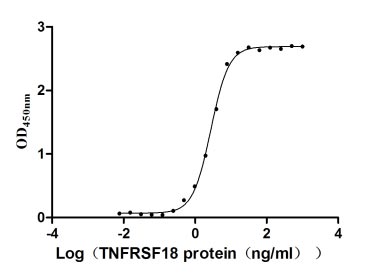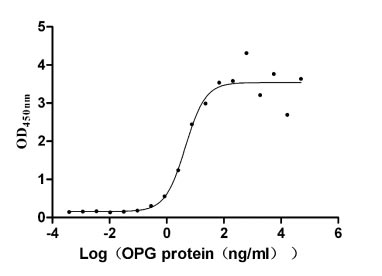Recombinant Human Bifunctional peptidase and arginyl-hydroxylase JMJD5 (KDM8)
-
货号:CSB-YP839789HU
-
规格:
-
来源:Yeast
-
其他:
-
货号:CSB-EP839789HU
-
规格:
-
来源:E.coli
-
其他:
-
货号:CSB-EP839789HU-B
-
规格:
-
来源:E.coli
-
共轭:Avi-tag Biotinylated
E. coli biotin ligase (BirA) is highly specific in covalently attaching biotin to the 15 amino acid AviTag peptide. This recombinant protein was biotinylated in vivo by AviTag-BirA technology, which method is BriA catalyzes amide linkage between the biotin and the specific lysine of the AviTag.
-
其他:
-
货号:CSB-BP839789HU
-
规格:
-
来源:Baculovirus
-
其他:
-
货号:CSB-MP839789HU
-
规格:
-
来源:Mammalian cell
-
其他:
产品详情
-
纯度:>85% (SDS-PAGE)
-
基因名:KDM8
-
Uniprot No.:
-
别名:FLJ13798; JmjC domain-containing protein 5; JMJD5; JMJD5 protein; jumonji domain containing 5; Jumonji domain-containing protein 5; KDM8_HUMAN; Lysine (K) specific demethylase 8; Lysine-specific demethylase 8
-
种属:Homo sapiens (Human)
-
蛋白长度:full length protein
-
表达区域:1-416
-
氨基酸序列MAGDTHCPAE PLAREGTLWE ALRALLPHSK EDLKLDLGEK VERSVVTLLQ RATELFYEGR RDECLQSSEV ILDYSWEKLN TGTWQDVDKD WRRVYAIGCL LKALCLCQAP EDANTVAAAL RVCDMGLLMG AAILGDILLK VAAILQTHLP GKRPARGSLP EQPCTKKARA DHGLIPDVKL EKTVPRLHRP SLQHFREQFL VPGRPVILKG VADHWPCMQK WSLEYIQEIA GCRTVPVEVG SRYTDEEWSQ TLMTVNEFIS KYIVNEPRDV GYLAQHQLFD QIPELKQDIS IPDYCSLGDG EEEEITINAW FGPQGTISPL HQDPQQNFLV QVMGRKYIRL YSPQESGALY PHDTHLLHNT SQVDVENPDL EKFPKFAKAP FLSCILSPGE ILFIPVKYWH YVRALDLSFS VSFWWS
-
蛋白标签:Tag type will be determined during the manufacturing process.
The tag type will be determined during production process. If you have specified tag type, please tell us and we will develop the specified tag preferentially. -
产品提供形式:Lyophilized powder
Note: We will preferentially ship the format that we have in stock, however, if you have any special requirement for the format, please remark your requirement when placing the order, we will prepare according to your demand. -
复溶:We recommend that this vial be briefly centrifuged prior to opening to bring the contents to the bottom. Please reconstitute protein in deionized sterile water to a concentration of 0.1-1.0 mg/mL.We recommend to add 5-50% of glycerol (final concentration) and aliquot for long-term storage at -20℃/-80℃. Our default final concentration of glycerol is 50%. Customers could use it as reference.
-
储存条件:Store at -20°C/-80°C upon receipt, aliquoting is necessary for mutiple use. Avoid repeated freeze-thaw cycles.
-
保质期:The shelf life is related to many factors, storage state, buffer ingredients, storage temperature and the stability of the protein itself.
Generally, the shelf life of liquid form is 6 months at -20°C/-80°C. The shelf life of lyophilized form is 12 months at -20°C/-80°C. -
货期:Delivery time may differ from different purchasing way or location, please kindly consult your local distributors for specific delivery time.Note: All of our proteins are default shipped with normal blue ice packs, if you request to ship with dry ice, please communicate with us in advance and extra fees will be charged.
-
注意事项:Repeated freezing and thawing is not recommended. Store working aliquots at 4°C for up to one week.
-
Datasheet :Please contact us to get it.
相关产品
靶点详情
-
功能:Bifunctional enzyme that acts both as an endopeptidase and 2-oxoglutarate-dependent monoxygenase. Endopeptidase that cleaves histones N-terminal tails at the carboxyl side of methylated arginine or lysine residues, to generate 'tailless nucleosomes', which may trigger transcription elongation. Preferentially recognizes and cleaves monomethylated and dimethylated arginine residues of histones H2, H3 and H4. After initial cleavage, continues to digest histones tails via its aminopeptidase activity. Upon DNA damage, cleaves the N-terminal tail of histone H3 at monomethylated lysine residues, preferably at monomethylated 'Lys-9' (H3K9me1). The histone variant H3F3A is the major target for cleavage. Additionnally, acts as Fe(2+) and 2-oxoglutarate-dependent monoxygenase, catalyzing (R)-stereospecific hydroxylation at C-3 of 'Arg-137' of RPS6 and 'Arg-141' of RCCD1, but the biological significance of this activity remains to be established. Regulates mitosis through different mechanisms: Plays a role in transcriptional repression of satellite repeats, possibly by regulating H3K36 methylation levels in centromeric regions together with RCCD1. Possibly together with RCCD1, is involved in proper mitotic spindle organization and chromosome segregation. Negatively regulates cell cycle repressor CDKN1A/p21, which controls G1/S phase transition. Required for G2/M phase cell cycle progression. Regulates expression of CCNA1/cyclin-A1, leading to cancer cell proliferation. Also, plays a role in regulating alpha-tubulin acetylation and cytoskeletal microtubule stability involved in epithelial to mesenchymal transition. Regulates the circadian gene expression in the liver. Represses the transcriptional activator activity of the CLOCK-ARNTL/BMAL1 heterodimer in a catalytically-independent manner. Negatively regulates the protein stability and function of CRY1; required for AMPK-FBXL3-induced CRY1 degradation.
-
基因功能参考文献:
- JMJD5 catalyzes stereoselective C-3 hydroxylation of arginine residues in sequences from human RCCD1 and ribosomal protein S6. PMID: 29563586
- Here, we report that JMJD5, a Jumonji C (JmjC) domain-containing protein, is a Cathepsin L-type protease that mediates histone H3 N-tail proteolytic cleavage under stress conditions that cause a DNA damage response. PMID: 28982940
- The protease activities of JMJD5 and JMJD7 represent a mechanism for removal of histone tails bearing methylated arginine residues and define a potential mechanism of transcription regulation. PMID: 28847961
- JMJD5 depletion increases the susceptibility of cancer cells to microtubule-destabilizing agents. PMID: 27715397
- JMJD5 is a tumor suppressor gene in HCC pathogenesis, and the epigenetic silencing of JMJD5 promotes HCC cell proliferation by directly down-regulating CDKN1A transcription. PMID: 26760772
- Data suggest that JMJD5 partially accumulates on mitotic spindles during mitosis; depletion of JMJD5 results in significant mitotic arrest, spindle assembly defects, and sustained activation of spindle assembly checkpoint. PMID: 26710852
- These results suggest that direct interaction of JMJD5 with HBx facilitates hepatitis B virus replication through the hydroxylase activity of JMJD5. PMID: 26792738
- Suggest JMJD5 as a potential oncogene in colon carcinogenesis. PMID: 26261525
- results reveal that JMJD5 is a novel binding partner of p53 and it functions as a positive modulator of cell cycle and cell proliferation mainly through the repression of p53 pathway. PMID: 26025680
- we provide genetic and biochemical evidence that the JMJD5/CDKN1A (p21) axis is essential to maintaining the short G1 phase which is critical for pluripotency in human embryonic stem cells PMID: 24740926
- RCCD1 and KDM8 form a histone demethylase complex. PMID: 24981860
- These results reveal that the N-terminal domain is essential for the nuclear localization of JMJD5 and its normal enzymatic function towards substrates in the nucleus PMID: 23948433
- JMJD5 has a role in regulating PKM2 nuclear translocation and reprogramming HIF-1alpha-mediated glucose metabolism PMID: 24344305
- The study reports high-resolution crystal structures of the human JMJD5 catalytic domain in complex with the substrate 2-oxoglutarate (2-OG) and the inhibitor N-oxalylglycine (NOG). PMID: 22851697
- JMJD5 is a post-translational co-repressor for NFATc1 that attenuates osteoclastogenesis. PMID: 22375008
- Data show that both Arabidopsis jmjd5 mutant seedlings and mammalian cell cultures deficient for the human ortholog of this gene have similar fast-running circadian oscillations compared with WT. PMID: 21115819
- show that JMJD5 (now renamed KDM8), demethylates H3K36me2 and is required for cell cycle progression. PMID: 20457893
- Identifies five novel candidate tumor suppressor genes in mouse, including Pou2f2, Hivep3, Jmjd5, Fbxl10 and a protein similar to human N4BP3. PMID: 16858412
显示更多
收起更多
-
亚细胞定位:Nucleus. Chromosome.
-
组织特异性:Weakly expressed in most cells. Highly expressed in breast cancer cells. Expressed in embryonic stem cells.
-
数据库链接:
HGNC: 25840
OMIM: 611917
KEGG: hsa:79831
STRING: 9606.ENSP00000398410
UniGene: Hs.145717
Most popular with customers
-
Recombinant Human Tumor necrosis factor receptor superfamily member 18 (TNFRSF18), partial (Active)
Express system: Mammalian cell
Species: Homo sapiens (Human)
-
Recombinant Human Tumor necrosis factor receptor superfamily member 11B (TNFRSF11B) (Active)
Express system: Mammalian cell
Species: Homo sapiens (Human)
-
Recombinant Human Tyrosine-protein kinase Mer (MERTK), partial (Active)
Express system: Mammalian cell
Species: Homo sapiens (Human)
-
Recombinant Human E3 ubiquitin-protein ligase ZNRF3 (ZNRF3), partial (Active)
Express system: Mammalian cell
Species: Homo sapiens (Human)
-
Recombinant Human Signal transducer CD24 (CD24)-Nanoparticle (Active)
Express system: Mammalian cell
Species: Homo sapiens (Human)
-
Recombinant Human C5a anaphylatoxin chemotactic receptor 1 (C5AR1)-VLPs (Active)
Express system: Mammalian cell
Species: Homo sapiens (Human)
-
Recombinant Human Claudin-9 (CLDN9)-VLPs (Active)
Express system: Mammalian cell
Species: Homo sapiens (Human)
-
Recombinant Human Complement component C1q receptor (CD93), partial (Active)
Express system: Mammalian cell
Species: Homo sapiens (Human)




















